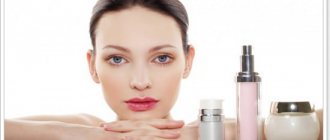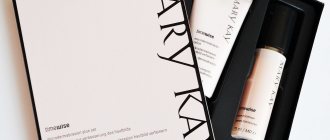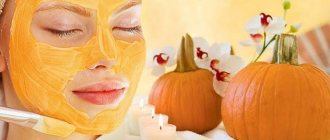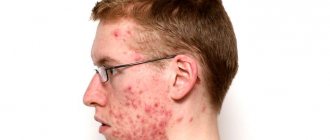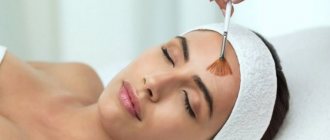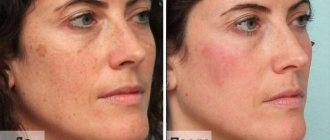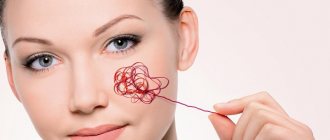What peeling to do in winter
This is true. Most exfoliating procedures should not be carried out in summer, late spring and early autumn. But when it comes to deep impact, winter is the best option.
It's all about the lack of ultraviolet radiation, from which we suffer so much, observing the sky constantly overcast for six months. For skin deprived of natural protection, solar radiation is fraught with burns and allergic reactions.
Let's figure out what kind of winter clothes every woman needs to make.
Medium peeling
For medium peels, acids such as retinoic, salicylic, and trichloroacetic are used. They are part of special products that the cosmetologist applies to the patient’s face. It is important to strictly observe the time it takes for the substance to penetrate the middle layers of the skin, otherwise unpleasant reactions may occur. As a result, the keratinized scales are destroyed, and the cells begin to actively recover - the process of self-rejuvenation begins. The skin is noticeably evened out, becomes fresh and radiant, pigment spots fade.
One procedure is not enough to achieve the desired result. You will need at least four of them, and at considerable intervals - from two to three weeks. That's why they postpone such serious peeling for the winter - the season is just enough to complete all the procedures and look great for the rest of the year.
Expected results of autumn cleansing
With timely and regular implementation of correctly selected procedures, you can count on a significant improvement in the general condition of the epidermis and some specific results:
- Peeling in the fall will cleanse your facial skin of any type of impurities like no other procedure. Sessions are equally effective for increased tissue fat, thickening of the stratum corneum, the formation of comedones and acne, accumulation of toxins, and the inability to completely remove remnants of decorative cosmetics due to enlarged pores.
- As a result of the acceleration of the removal of keratinized scales, the surface of the skin is leveled, the tissues become smooth and soft.
- Peels increase tissue permeability, facilitating the penetration of nutrients, moisturizers, and vitamins.
- Mechanical cleaning allows you to improve the functioning of blood vessels. At the same time, the complexion is evened out, compactions and infiltrates disappear, shadows under the eyes disappear, and the vascular mesh comes off the surface of the skin.
- As a result of deep cleansing of tissues and removal of secretions from the pores, the ducts of the sebaceous tubules narrow, pore craters are restored, and the skin becomes denser and more uniform.
- In late autumn, it is already possible to carry out rejuvenating manipulations of the middle and deep type. A low risk of complications and side effects, a quick recovery period and a milder course of the epithelization process lead to a lasting and pronounced positive effect. Over the next months, you can safely carry out the required maintenance procedures.
- Metabolic processes and the synthesis of building materials for tissues are established and stabilized in tissues. Starting in autumn, you can make full use of all the necessary types of facial skin care aimed at eliminating aesthetic and physical defects, restoring youth and freshness of the epidermis.
We suggest you find out what vitamins are missing in dry hair
There are highly targeted cleanses that give specific expected results. This can be the removal of scars, warts and moles, elimination of pronounced age spots and comedones, neutralization of the vascular network, softening of rough areas.
Laser peeling
This procedure is carried out using a laser. Its task is to literally dry out the upper layers of the skin, evaporating the liquid from them. As a result, their place is taken by deeper ones, untouched by any harmful effects. Naturally, all this does not go unnoticed by the skin. For a long time she remains very sensitive and vulnerable. Experts generally do not recommend their clients to leave the house during this period, even in winter.
If everything is done correctly, light expression wrinkles disappear, the skin begins to actively produce collagen and renew itself. The procedure is quite complicated, especially aftercare, but the game is worth the candle. The effect can last for five years, which is a long time without surgical intervention.
A few secrets of successful peeling
If you decide to do peeling in winter, you need to carefully prepare for the procedure. You can’t just walk down the street, look into a beauty salon and come out looking beautiful.
Firstly, there are many contraindications for serious interventions, the most serious of which is the exacerbation of any chronic disease. To make sure everything is in order, it is best to undergo a medical examination.
If you are regularly bothered by herpes, then before surgery you need to consult a specialist and undergo a course of appropriate therapy. The fact is that after peeling you risk experiencing an exacerbation.
In order for the procedure to give a more noticeable result, two to three weeks before it you need to visit a cosmetologist and get a softening agent from him. It should be applied to the skin regularly.
The healing process will go faster if you take a course of vitamins and omega-3 fatty acids before peeling. This will be beneficial for the body as a whole. You will also have to give up smoking and alcoholic beverages. Cigarettes are especially harmful to healing because they interfere with normal blood circulation in the vessels.
Every girl wants to have healthy and clear skin. Each of the fair sex knows how difficult it is to achieve an ideal appearance, especially if problems appear frequently and for a long time. However, you can completely transform and refresh your skin if you start doing it in a timely manner. The winter period is an ideal opportunity for long-awaited changes.
It would seem that frost and cold are in no way associated with matte and clear skin, but cosmetologists are in a hurry to dispel this misconception. The fact is that it is in late autumn and winter that the season of peelings and similar facial procedures should begin. The essence of peeling is to cleanse the skin of lifeless and dead cells, which helps restore important functions and acquire a smooth, toned and clean appearance. Having done the procedure once, you will quickly notice the first results and continue the course you started.
Professional peeling in a beauty salon can solve almost all external problems: from facial wrinkles, scars to serious (deep) skin damage. The procedure is carried out at an exclusively specified time, not at the whim of cosmetologists, but due to the weather conditions in summer and spring. The fact is that excess sun exposure on treated skin can aggravate the situation and lead to pigmentation.
Briefly: when and what peelings to use
The main guideline in choosing a peel is the client’s skin condition and complaints.
- For problematic skin with oily shine and enlarged pores, OILY-Skin Control is ideal. The drug regulates the functioning of the sebaceous glands and fights inflammatory processes. It is gentle and does not dry out the skin.
- If the client is concerned about age-related changes, we recommend REPAIR-Skin Control. A great option if you need a quick anti-aging procedure. The drug will return a healthy glow to the face, eliminate shallow wrinkles and hyperpigmentation.
- For severe skin imperfections, we recommend KERATO-Skin Control. The most powerful product in the ARAVIA Professional peeling line. Works with hyperkeratosis, seborrheic keratosis, photo and chronoaging.
Three types of peelings: we understand the features and differences
Of course, the most accurate answer can be obtained in a cosmetology salon after preliminary diagnosis. But no one has yet prohibited knowing general information. The most common “troika” of peelings are:
- Chemical. After applying the selected chemical solution, exfoliating and restorative functions are launched. Peeling most likely will not give you pleasant sensations during application. Therefore, girls with a high pain threshold should think several times before the procedure;
- Ultrasonic. Now it is called hardware cleaning, but the essence of the method does not change. A special device helps to resolve congestion and improve appearance;
- Laser. Otherwise, peeling can be called laser resurfacing. The most effective, and therefore expensive pleasure (you will have to pay more than 5,000 rubles at a time). The effect on the skin occurs thermally. Due to high pain, anesthesia may be required.
Types of peelings by depth of penetration
Procedures vary in depth of penetration and subsequent recovery period.
For example, after deep peeling (suitable only for women over 50 years old) aimed at destroying the epidermis, the skin will “come to its senses” in one to two weeks. The result, by the way, deserves patience. Often, with the help of deep peelings, the effects of post-acne, wrinkles and nasolabial folds are corrected. Using medium peeling helps eliminate early aging, first wrinkles, acne and other imperfections. Adaptation does not take more than 7 days. Superficial peelings with salicylic, lactic, and citric acids are suitable as a preventive measure only for girls with good skin.
It is important to remember that visiting a solarium, sauna, or walking in the open sun after peeling is completely prohibited. If possible, it is necessary to reduce your time on the street, giving preference to home gatherings.
Possible complications after winter peelings
Despite the fact that winter is the optimal time for most anti-aging procedures, especially those based on acids that increase the photosensitizing properties of tissues, some complications are still possible. Usually they occur in the case of individual characteristics of the body, incorrect selection of the procedure or neglect of the preparatory stage.
Improper peeling in winter can cause the following consequences:
- Thinning of the skin as a result of too frequent manipulation.
- Increased tissue sensitivity when using aggressive compounds for regular cleaning. It is for this reason that it is better to give preference to products designed to care for sensitive epidermis.
- With insufficient or irregular use of vitamins, a decrease in cellular immunity may occur. This leads to the risk of frequent development of herpetic infections, manifestations of vitamin deficiency, inflammatory processes, and fungal diseases.
- Abuse of acid peels will slow down the process of natural epithelization. The skin will not be sufficiently protected from cold air and aggressive weather conditions, which can lead to the formation of cracks and small bruises as a result of increased fragility of blood vessels.
- Peeling in winter should be accompanied by complete restorative care. If you neglect the recommendations of a specialist, you can just as easily, as in the summer, get the formation of age spots and chemical burns with the further formation of scar tissue.
- During the winter period, it is recommended to refrain from cryotherapy. The effect of cold on the skin after cold can lead to unexpected and very unpleasant consequences.
The listed complications are extremely rare and only with complete disregard for the rules of manipulation. Properly selected procedures performed by an experienced cosmetologist will leave only positive results. Don't forget about home skin care techniques. In the winter months, they are not only relevant, but even necessary.
Tags: do, winter, autumn, period, peeling, why
« Previous entry
What else can you do to please your face during the frosty seasons?
If you have not yet been able to decide on the aggressive effects of acids and lasers, this does not mean that a trip to a cosmetologist should be postponed until next winter.
On the eve of the holidays and huge financial expenses, it is better to donate a small amount for your loved one. Fortunately, you can look well-groomed and fresh even after the usual mechanical, combined or vacuum facial cleansing. The difference between a professional approach and a home one is the use of special devices that minimize skin trauma. But, alas, you won’t be able to avoid the pain: in order to rid you of impurities as much as possible, the cosmetologist will have to press a little (you can expect special sensations from cleaning the pores on your nose). Those who want to leave the cleansing “for dessert” and do it on the 30th of December should prepare themselves for the fact that the redness and wounds will disappear within 2-4 days.
Of course, this is not the entire list of what a cosmetologist can offer a girl. Depending on your skin type, they will select appropriate care for you, recommend a mask, scrub, or give recommendations on further actions.
You shouldn’t neglect cosmetology, because the sooner you start solving existing problems, the sooner you’ll say goodbye to them forever. Reflection in the mirror can instantly improve self-esteem and mood, and therefore it is in your interests to be beautiful every minute.
When choosing a peel, almost all of our patients are lost and don’t know what to look for. First of all, calm down and stop nervously searching for all possible information on the Internet. Why? Because no one other than a doctor can tell you exactly which type of peeling is right for you. Always keep in mind that everyone has different characteristics, different skin types, different reactions. Therefore, everyone is treated individually. So your best decision would be to schedule a consultation with a cosmetologist at Cleo Line.
And already during the examination, the doctor will be able to select the appropriate peeling for you. Their diversity is determined by:
- depth of impact - there are superficial, medium and deep peels
- having an effect - depending on the composition, peelings fight different skin problems. This may be an uneven complexion, acne, scars, peeling, increased sebum secretion, etc.
- seasonality - there are peelings that can be done at any time of the year, but there are also those that are indicated only in the autumn-winter period
Why is it recommended to do peelings in the autumn-winter period? The answer is simple - it's all about the activity of the sun. In winter, the sun is least active, so the risk of injury to the skin after peeling is reduced significantly. And excessive exposure to the sun after peeling can injure the skin, cause unpredictable reactions and hyperpigmentation, since the skin after treatment remains sensitive to any environmental changes. If you want everything to go smoothly (in every sense), we recommend that you do peelings in the autumn-winter period. Another advantage of winter peelings is the reduction in the concentration of dust and contaminants in the air. We want to have clear skin, right?
What peelings are available
Peels that can only be done when sun activity is low include:
It is aimed at removing freckles and other age spots. This peeling perfectly moisturizes the skin due to the acids it contains (salicylic, lactic) and resorcinol. The depigmenting effect is achieved through hydroquinone, kojic and citric acids. The full rehabilitation period lasts about 10 days.
Its main difference is that it copes well with the signs of aging and skin aging. This peeling can be applied not only to the face, but also to the neck and even to the décolleté area. Retinoic peeling is a medium peeling that has an effect down to the basal layer of the skin. This means that the rejuvenation process will be more serious than with superficial peels. Retinoic peeling also removes fine wrinkles and normalizes collagen synthesis in the skin.
Also classified as medium peels. Its main component is trichloroacetic acid, the concentration of which the doctor selects independently after examining your skin. Each patient at Cleo Line has individual treatment! Indications for TCA peeling will be: enlarged pores, flaky skin, hyperkeratosis (a skin condition in which there is a thick stratum corneum of cells), and the presence of hyperpigmentation. We can say that TCA peeling is universal, as it combats the main and most common problems.
stands on a par with the middle ones, but in fact it is superficial. This peel works on oily skin, pigmented skin, acne marks. The Jessner peel does not work quite like regular peels. If the usual ones are washed off at the end of the session, then this peeling is left on the face. A special composition is applied to the top, which acts as a protective film. In addition, a protective cream is applied to the face.
A mandatory procedure for those who have constant rashes and pimples on their skin. Salicylic acid acts as a disinfectant that kills all bacteria that cause acne and comedones. At the same time, it regulates the functioning of the sebaceous glands and dries the skin.
These are the main peels that are usually done in autumn and winter. On the recommendation of a doctor during these times of the year, of course, you can do all-season ones. But they are usually superficial and are not aimed at serious skin treatment.
Before carrying out the procedure, consultation with a doctor is required.
We often hear from cosmetologists that autumn is the time for peeling. Why do experts insist on this particular season, what is the secret? After all, we believe that the best time for peeling is when the problem has just arisen and has not received a “big resonance.”
But everything is not as simple as it seems at first glance. The time of peeling must be chosen wisely so that the expected effect does not cause complete disappointment. Are there many questions that are not yet answered? Let's sort it out in order.
The autumn season is marked by a decrease in solar activity, ambient temperature, changes in humidity and other climatic indicators. In addition, autumn gives way to summer, when our skin is exposed to hot sun, dry air and other physical factors.
Peeling in the fall is as necessary as air. After all, it will rid the epidermis of accumulated keratinized particles, which, due to objective reasons, are quite difficult to exfoliate in the summer. And these are not all the reasons why the cleansing procedure is carried out at this time of year.
- High-quality removal of pigmentation. Ultraviolet radiation provokes increased production of melanin and dark spots appear on the face, as the most exposed part of the body.
- Signs of photoaging. Again, our beloved sun “tried” and rewarded us with a network of fine wrinkles, especially if no protective agents were used. The procedure will help to effectively resolve the problem.
- High ambient temperatures, low humidity, changes in climatic conditions (a trip to the sea or to the mountains) provoke excessive dryness of the skin. It begins to peel off and microcracks form, which can easily become infected. Again, autumn peeling helps to cope with this problem and has a preventive effect, preventing inflammatory processes and all the “delights” associated with them.
- Although autumn is rightfully considered the richest time, the change of seasons always causes vitamin deficiency. Peeling compositions not only cleanse the epidermis, but also saturate it with moisture and nutrients. In addition, the skin's sensitivity to nourishing and moisturizing cosmetics improves, and blood circulation and regeneration processes are stimulated.
The main criteria for the justification of autumn peelings:
- solar activity decreases in the autumn season, which is very good. Why? After peeling procedures, the skin becomes very sensitive, thin and vulnerable. It will take some time to recover (from a week to several months, depending on the type of procedure). Natural ultraviolet light will not harm delicate skin;
- The course of peeling can be divided over time. To achieve the desired visible effect, cosmetologists advise doing several manipulations over a certain period of time.
If you don’t have the time, financial capabilities or desire to visit a salon for professional cosmetic procedures, this is not a reason to refuse independent cleansing sessions. Fortunately, for such purposes there are many purchased products and recipes for preparing active compounds yourself.
Now we are considering the aspect of what peelings can be done in the fall. Based on common sense, it is advisable to carry out almost all of these procedures during the period of least solar activity in order to minimize the negative impact of ultraviolet radiation on delicate skin.
Among the proposed autumn facial peels, each woman will be able to choose the appropriate option for herself, taking into account her existing problems and individual characteristics.
Mechanical peelings are the most common and popular among superficial procedures. They can be carried out both in salons and at home. The protocol involves the use of products with abrasive particles (that is, scrubs, as we used to call them). These can be purchased products or home-prepared formulations. Expected effect:
- mechanical removal of keratinized particles;
- improvement of blood microcirculation;
- stimulation of internal processes - oxygen metabolism, absorption of nutrients, skin regeneration, synthesis of collagen and elastin;
- getting rid of facial wrinkles;
- removal or minimization of pigmentation;
- light lifting effect.
Physical peelings or hardware peels are carried out only on the recommendation of a cosmetologist and it is better to carry out manipulations in the salon. These are laser, ultrasound or vacuum procedures. They will help:
- get rid of acne and post-acne;
- remove age spots, even pronounced ones;
- fight comedones, sebaceous plugs, acne, inflammatory processes;
- stop the aging process;
- stimulate the synthesis of your own protein compounds responsible for the condition of the skin;
- improve color, even out microrelief, tighten the oval of the face.
To carry out peelings in the autumn with maximum effect, you should pay special attention to chemical procedures. Such manipulations cause a targeted chemical burn, which forces the body to seek hidden reserves for recovery.
Chemical peels are very diverse. They are divided into several types according to the depth of impact on epidermal tissue. And each of the options effectively combats a whole list of problems.
- Superficial procedures are the most gentle. To carry them out, products with a low concentration of acidic components are used. These are mainly fruit or lactic acids. Sessions can be carried out either with a cosmetologist or independently.
- Medium exposure involves the use of formulations with a higher concentration of aggressive substances. This is a salicylic peel using trichloroacetic acid, retinoic (yellow). With their help, you can solve more serious problems, get rid of severe pigmentation, acne marks, and wrinkles. The structure of the skin is restored, color and microrelief are improved.
- Deep peeling is a procedure similar to plastic surgery. It is carried out only in a hospital setting. The effect is so deep that even the basal layer of the dermis is affected. The manipulation is quite painful and is carried out only under anesthesia. Since the process uses phenol (a toxic substance), monitoring of cardiac activity is necessary. Preparation for such a procedure is very serious, as it has a long list of contraindications.
Medium and deep peelings are purely salon methods of cleansing and rejuvenating the skin. And if some types of the middle are still allowed for independent implementation, then the deep is entirely the prerogative of specialists.
As we have already found out, autumn is the time for peeling. What do cosmetologists advise regarding the choice of procedure?
- Mechanical peelings can be carried out at home, using both purchased and self-prepared products. To cleanse in the fall, you can use coffee grounds with honey and cream, sea salt (crushed), sugar, oatmeal and other products that you always have on hand.
- Hardware peelings are carried out by experienced specialists according to clear indications. Especially laser and ultrasound. Despite the apparent simplicity of the manipulations, their painlessness, minimal side effects and a relatively short recovery period, the procedures have contraindications that only a professional can take into account.
- Superficial chemical peels should be selected taking into account the characteristics of your skin. So milk peeling is an ideal option for young epidermis with a tendency to dryness and few problems. Glycolic – for oily skin with signs of age-related changes.
- The average effect is justified in the presence of pronounced problems and age-related changes. Salicylic - for problem skin, trichloroacetic is recommended for women over 35 years old, retinoic - for loss of color and decreased turgor.
- Deep - only for women over 45-50 years old for clear indications. Conducted once a year at least. However, experts say that such an effect with adequate care is enough for a period of up to 3-5 years.
- The course of superficial procedures ranges from 5 to 7 at weekly intervals. Next, you need to use soft, gentle scrubs at home regularly at least once a week to maintain the effect.
- Medium effects, depending on individual characteristics, may require from 3 to 5 sessions with an interval of 2-4 weeks.
Regardless of the time of year, it is necessary to use sunscreen. After peeling, even in autumn, before going outside, you need to use products with a UV protection index of at least 30.
Note! Cosmetologists warn that winter is not the best time for cleansing procedures. Frost, wind, changes in temperature and humidity (outdoors - indoors) have a detrimental effect on the condition of thin, delicate skin after peeling.
What effect can you expect from peeling?
Thanks to chemical peeling, the skin texture is evened out, which is important for oily and porous skin, and in the presence of acne marks; pigment spots are lightened; the number of fine wrinkles, including around the eyes, decreases; turgor improves, and the skin takes on a glowing and well-groomed appearance. Depending on the problem, the appropriate peeling is selected.
Expected effects from chemical peeling:
Improved appearance, turgor and elasticity. Correction of hyperpigmentation. Smoothing the skin profile: reducing the size of skin pores, leveling out fine skin wrinkles. Activation of metabolic processes in the skin and, as a result, an improvement in complexion, the skin becomes denser and more elastic. The stimulating effect on the skin is realized indirectly through the inflammatory reaction in response to strictly dosed chemical damage. Whitening effect. Is it possible to independently determine whether chemical peeling or some other procedures are needed to improve the condition of the skin?
Indications and contraindications for the peeling procedure should be judged by a qualified specialist; what is an indication for the procedure for one type of peeling or a particular patient may be undesirable for another patient.
Indications for the use of peelings can be divided into several groups.
First indication: aging skin. The rejuvenating effect is achieved by stimulating cells. As a result, tissue tone improves and the severity of wrinkles decreases.
Second indication: skin with hyperpigmentation. The peeling procedure normalizes melanin levels and pigmentation disappears.
Third indication: acne-prone skin. Glycolic acid is a natural antiseptic. Peeling normalizes the functioning of the sebaceous glands and is a good means of preventing scars that appear after acne.
Fourth indication: cosmetologists work with glycolic acid when solving stretch marks problems. Stimulation of cells leads to improved skin tone, stretch marks become less noticeable, and the skin becomes more toned and elastic.
Fifth indication: preparing patients for cosmetic procedures. After peeling, the skin's potential increases, which is necessary for recovery after the procedure.
What is the difference between superficial peeling and medium peeling?
Superficial chemical peels (AHA, or fruit acids) are a pleasant, relaxing procedure: a thin layer of acid is applied to a cleansed face, then it is neutralized and washed off. Such peelings do not require disruption of work rhythm and restrictions in communication. A day or two after the procedure, the skin begins to peel off slightly, but if the cosmetologist’s recommendations are followed correctly, those around you will not notice this. But they will notice that your skin is fresher. Superficial peeling is a gentle procedure. Therefore, if your goal is not limited to getting yourself in order for an important event in a few days, but you need a lasting result, one procedure will not be enough. The optimal course is 4-6 procedures.
Medium peels (for example, TCA - trichloroacetic acid) are recognized by both patients and cosmetologists as the most effective. And, although the skin feels them more acutely than superficial ones, a burning sensation is felt, redness appears, there is something to endure for the sake of it. Thanks to medium peeling, the skin gains a second youth - it becomes fresh, tightened, its previous structure is restored, pronounced age-related pigmentation disappears, wrinkles of even medium depth are smoothed out, and some scars are evened out. Already 7-10 days after the procedure, you can wear makeup and calmly appear in public without fear of being “exposed.” And after 2-3 weeks, when traces of redness finally disappear, your skin will gain freshness, become young and beautiful.
Is it possible to perform one peeling procedure or is a course required?
Superficial peeling is performed as a one-time procedure or in a course of 5-10 procedures with an interval of 3 to 6-10 days. Medium peeling program for TCA15% 3-5 procedures with an interval of 1-3 weeks, for TCA20-25% 2-5 procedures with an interval of 1 month.
A dermatocosmetologist at our Beauty Center will help you create a program of peeling procedures taking into account the individual characteristics of your skin.
Summary
Let's summarize. The effectiveness of peelings in the autumn period is the highest. It is at this time that you can use more active products to tidy up your skin.
But you should also remember that aggressive procedures should not be abused. After all, the body’s internal hidden reserves are not limitless. There may come a time when the “safety margins” simply run out. Then no force will force your body to recover. After all, the skin is the largest organ, which also has its ultimate maximum.
It has long been no secret what peeling is, how and where it can be done. Its main purpose is to cleanse the skin and rejuvenate it. It is thanks to the right type of peeling that the skin can be restored to its former freshness, health and attractive appearance.
The main thing is to choose the right procedure and be sure to consult with a cosmetologist who will tell you not only how to do the procedure, but also select an individual course of cleansing and rejuvenation of the skin, which is important in such a serious procedure for the skin.
Peeling products and types of procedures
In cosmetics stores, you can often buy peeling masks that act on the skin mechanically due to the microgranules they contain. But in professional cosmetics stores you can buy more aggressive products for this procedure and most often they are based on acids. These types can be performed in salons and also at home, subject to all precautions and rules of the procedure.
There is also vacuum peeling and laser peeling, which are definitely carried out by a specialist using special equipment.
Recommended salon manipulations in the autumn
Cosmetologists are of the opinion that the most suitable time of year for cleansing the skin is from October to April.
An important role here is played by sun activity, gusty winds or dry air, any external factor that can injure delicate, renewed skin.
Peeling is the cleansing of the surface of the face from the stratum corneum of dead cells.
Depending on age, this cleansing is carried out on different layers of the epidermis (there are only five):
- Superficial affects the first and second layers.
- Middle - second and third layers.
- Deep - third and partially fourth layer.
Any impact on the skin (mechanical, chemical or hardware cleansing) removes its protective barrier, exposing a new delicate layer that requires delicate care.
It is easiest to protect renewed skin from ultraviolet radiation, temperature changes, dry air, and extreme heat in cold weather.
Therefore, medium and deep peels are prescribed strictly in late autumn or winter. Modern cosmetology is not as conservative as it was 10 and 20 years ago.
There are many types of cleansing that solve different problems and can be carried out at any time.
It's time for medium and deep peels. After such procedures, the skin goes through a long rehabilitation period; it recovers from three to six months, depending on the depth of cleaning.
The entire period after cleansing, the epidermis is very susceptible to ultraviolet radiation. Even minimal exposure to direct sunlight can cause a 1st or 2nd degree burn.
Which will lead to either severe pigmentation or the appearance of painful blisters, followed by wounds and burn marks.
Preparation: in winter there is a decrease in immunity; inflammation, microcracks or foci of the herpes virus often appear on the skin of the face.
Therefore, a month before the proposed cleansing procedure, you need to take immunostimulating drugs.
Efficiency:
- Winter cleansing forms a reserve of nutrients inside the dermis;
- Metabolic processes are being established;
- The production of collagen and elastin is launched (lifting effect);
- The efficiency of perception of oxygen, vitamins and minerals at the cellular level increases;
- The walls of blood vessels are strengthened, internal blood flow improves.
Autumn
https://www.youtube.com/watch?v=EDMIfUsA7p4
Features of peeling after the end of summer: a more suitable season for mid- and superficial procedures.
Cleansing aimed at restoring dehydrated and dry facial skin is popular.
- Fruit is a gentle procedure based on natural acids (tartaric, malic, citric) of low concentration (up to 30%). Eliminates the first signs of aging, fine wrinkles, pigmentation, moisturizes the skin, evens out the color and structure of the facial surface.
- Enzymatic - superficial or middle. Suitable for dry, thin and very sensitive skin. Eliminates the visible network of capillaries, saturates cells with oxygen, nutrients, and improves color.
- Glycolic - dry cleaning with acid. Effectively smoothes fine wrinkles, refreshes, moisturizes the surface of the face, eliminates visible blemishes (acne marks, small scars, scars) and signs of photoaging.
- Retinoic - triggers the production of “fibers of youth” collagen and elastin, tones the skin, evens out the structure, and makes the facial contour clearer.
Spring
In spring, the skin displays a general decrease in body tone, signs of deficiency of vitamins and microelements: dull color, dryness, flaking.
Types and effectiveness: in spring it is better to carry out only superficial cleansing to replenish and moisturize the surface of the face.
All these cleansing methods effectively moisturize the skin, smooth the surface, improve complexion, whiten, normalize melanin production, which well prepares the skin for the effects of ultraviolet radiation.
Summer
During the hot season, peeling is used to prepare the epidermis to obtain an even, uniform tan.
The second option is to rid your face of the first signs of photoaging and eliminate dryness.
In summer, only superficial peels are recommended, which are the most gentle and delicate.
The most important thing is post-peeling care, constantly use sunscreen, apply a nourishing or moisturizing cream to your face every day, and avoid dehydration.
Peels that can be done in spring and summer:
- In winter, chemical peels are popular: trichloroacetic, phenol, pyruvic, azelaic, glycolic.
- Hardware resurfacing methods: microcrystalline dermabrasion or laser cleaning.
Spring
- Surface fruit (acid concentration no more than 30%);
- Coral;
- Cryotherapy;
- Fitinous.
Summer
- Lactic;
- Almond;
- Salicylic;
- Ferulic - removes toxins, significantly reduces the thickness of the keratinized layer of cells.
Peeling in the fall can be of any type. This is the optimal time both for sessions that increase the photosensitizing properties of tissues, and for cryotherapy options, which are not recommended in winter.
- superficial hardware cleaning. Allows you to maintain facial skin in normal condition for a long time. They stabilize metabolic processes, increase tissue tone, restore the epidermis after prolonged exposure to the sun and chemical exposure to toxins, salt water, and sweat.
- superficial mechanical cleaning. They accelerate the removal of keratinized scales, improving cellular respiration and increasing tissue permeability. After such preparation, the epidermis receives maximum nutrition, hydration, and is saturated with vitamins and medicinal substances. Multi-level massage stimulates blood circulation and lymph outflow.
- surface chemical cleaning. Gently cleanse the skin of all excess, preparing the tissues for more intensive types of treatment or application of serums, creams, lotions. This is the most convenient and effective way to deliver vitamins, mineral salts and nutritional components to cells. Superficial peeling in the fall using fruit or other photosensitizing acids is absolutely safe if basic safety rules are followed.
- surface enzymatic and peptide cleanings. Taking into account the fact that most peeling compositions of the enzyme and peptide type also contain fruit acids, which increase tissue permeability and the effectiveness of manipulation, the features of their implementation are equivalent to conventional surface chemical cleaning.
- mid-enzyme and peptide cleansing. Manipulations whose action is aimed at normalizing biochemical processes in tissues. These are low-traumatic and very effective procedures that can relieve many aesthetic problems that arise against the background of vitamin deficiency and the change of seasons.
- combined coral peeling. A unique manipulation that combines several types of effects on the epidermis and underlying tissues. Carrying out a session in the summer or spring is possible, but due to the pronounced intensity of the procedure, it is not always desirable. Coral peeling in the fall will rid tissues of toxins accumulated during the warm months, stimulate the functioning of blood vessels, and have a positive effect on biochemical processes.
- deep and medium chemical cleaning. This type of manipulation is recommended to be carried out in late autumn. Sessions will eliminate pronounced signs of tissue aging, scars, acne of any severity and pigment spots of varying depths.
- aggressive hardware cleaning. This may include the use of a hot laser. This type of intervention is very popular due to its high efficiency, but given the availability of modern analogues that are less aggressive and similar in effectiveness, the procedure is carried out only for express indications.
We suggest you familiarize yourself with How to tighten a sagging belly at home DETAILS
: Features of glycolic peeling at home
Basically, peeling in winter is carried out with the aim of restoring the protective properties of the epidermis and increasing tissue resistance to sudden temperature changes. In addition, the procedures used can perform the following functions:
- Saturation of tissues with vitamins, mineral salts, nutrients and special fats. The latter component does not in any way affect the fat content of the epidermis, but ensures the maintenance of cell shape. In addition, constant energy production prevents water from freezing.
- Thoroughly cleanse the surface of the face from remnants of decorative cosmetics. This is a very important point in regular care. Some substances included in cosmetic preparations (especially inexpensive brands) can crystallize in the cold, causing a violation of the integrity of cell membranes. This leads to the formation of inflammation, ulcers, and cracks.
- Increasing cellular immunity, preventing the occurrence and spread of herpes infection.
- Peeling your lips in winter prevents hypothermia, drying out of the mucous membranes and the appearance of cracks on them. Delicate skin is renewed without the formation of crusts, ulcers and bruises.
- Certain types of peelings strengthen the walls of capillaries, reducing their fragility, and normalize blood flow. This not only significantly improves complexion, but also prevents the formation of infiltrates, congestion, and hematomas.
All of the above effects are achieved not only with the help of salon techniques, but also with available home peelings. The main thing is the regularity of the procedures, the correspondence of the chosen technique to the existing problem, the use of manipulations selected according to the type of epidermis.
Some types of cleansing are especially useful in winter. Basically, these are chemical peels of salon, professional and home types.
- Enzyme cleansing. They do not violate the integrity of the skin, act very gently, and are highly effective. Together with enzymes, it is possible to introduce vitamins and nutritional components into the skin. According to experts, this is one of the most optimal methods of tissue nutrition during the winter period. By adding a small amount of fruit acids to the compositions, you can also perform high-quality facial cleansing with a slight rejuvenating effect.
- Milk peeling. One of the mildest acid cleanings. It can be carried out even with rosacea and used to care for sensitive skin. An excellent way to moisturize tissue, even out complexion, and alleviate acne.
- Phytin peeling. Even in winter, there may be increased activity of sunlight, leading to the formation of fine wrinkles. Cleansing based on phytic acid can effectively combat the signs of photoaging.
- Cleaning with mandelic acid. Allows you to even out the structure of the epidermis, so it is perfect for caring for combination skin. Can be used as an express remedy to instantly improve tissue condition.
- Glycol cleansing. This peeling in winter allows you to gently smooth out the stratum corneum of the epidermis, improve cellular respiration and lipid metabolism.
- Pyruvic peeling. An indispensable procedure for vascular dysfunction. Helps get rid of dark circles under the eyes, swelling of tissues, the formation of swelling and infiltrates, and decreased tone of the epidermis.
- Salicylic and retinol peels can be used very carefully and only when indicated. The products reduce the excess oil content of the skin and prevent the formation of inflammatory processes.
- Retinoic peeling. Helps improve the condition of problem skin. Can be used locally to eliminate acne and prevent its consequences.
- Trichloroacetic peeling. In addition to the impressive list of therapeutic effects that this cleansing has, the manipulation perfectly rejuvenates the skin. It is for this quality that sessions are especially valued by patients. A high concentration of trichloroacetic acid is used to perform deep cleansing to get rid of scars, deep wrinkles, and physical defects. The substance can burn through tissue, which in summer conditions can lead to serious complications. Peeling in winter also involves certain risks and requires special restorative care, but in any case it is not so dangerous.
- Salicylic cleansing. A gentle but effective way to improve the condition of oily and problematic skin. There are two cleaning options: soft and hard. Gentle peeling can be used with caution in the summer. Hard cleanings are more effective, but due to certain specifics, they are recommended to be carried out in winter.
- Jessner peeling. Cleaning causes intense peeling, so using it in the summer is very problematic - the risk of developing inflammatory processes is too high. In winter, such manipulation allows you to even out the stratum corneum of the epidermis and start rejuvenating processes. The intensity of the impact can be controlled by changing the number of layers.
We suggest you read: Why does the face swell after a night?
Frequency of peeling
In order to get the desired result, one peeling procedure is not always enough. Most often, a course of skin rejuvenation and healing is required, which also directly depends on the skin type, type of peeling and the desired result. Therefore, only a specialist in this field can answer the question of how many procedures need to be done.
Most chemical peels take a course of 4-6 procedures with an interval between each procedure of 7 days for oily and normal skin, 14 days for normal skin, 14-21 days for dry and very sensitive skin. Although here too it is impossible to give unambiguous recommendations, since, for example, peeling with citric acid is carried out according to this schedule, but peeling with calcium chloride can be done every other week for any skin type.
How often can you do a facial peel?
The cosmetologist prescribes the course of peeling and its frequency individually and according to indications. With maintenance care and prevention, this is usually a course of 3-5 procedures once a year. As for homemade cosmetics, they can be used all year round, but with caution during the season of increased solar activity. And in any case, use a product with SPF.
How often can you do a facial peel?
Our review presents peelings for home use, both acidic and mechanical.
Acid peels
How to peel correctly
Any type of peeling means complete cleansing of the skin, so the skin must first be cleaned mechanically using even ordinary water. Ideally, it’s a good idea to steam your skin in the bath or shower; you can make a steam bath for your face. Most often it is done on the face, neck and décolleté. They should also be cleaned and steamed.
After this, the peeling mixture is applied to the skin with light massage movements. The eye and lip areas are excluded when applied; for some types of peeling, the mixture should also not be applied to the area between the nose and lips.
Peeling on the skin is maintained for the required amount of time and then carefully washed off. The mixture must also be removed from the skin correctly. To do this, apply a small amount of water to the skin and rub the mixture over the skin again. Gradually the amount of water increases, and if necessary, the remaining peeling can be removed with special cotton pads.
What is peeling and how to do it correctly
Chemical peeling of the face by a cosmetologist
Facial peeling at home
Home Peeling. Malysheva About Home Peeling
Chemical PEELINGS. What do you need to know?
After peeling, the face and other areas of the body to which the mixture was applied are usually washed with cold water. But some of them can be washed off with heat, so during the procedure you must follow the rules of the procedure.
It is very important to apply appropriate skin care product after the procedure. Most often this is a moisturizing face cream, but in some cases it is recommended to apply a nourishing or even baby cream.
Precautions for the procedure include any damage to the skin, excessive sensitivity, irritation, as well as any contraindications to one or another type of peeling.
Rules and features of using winter peelings
Carrying out cleansing, therapeutic and rejuvenating procedures during the winter period must be carried out according to strict rules. They relate to the composition of products, manipulation techniques, preparation for interventions and compliance with the characteristics of the recovery period.
- As for peelings and surface scrubs used for regular care in order to prepare tissues for manipulation and maintain the resulting effect, it is necessary to choose the mildest formulations. It is recommended to use products that are otherwise used for sensitive skin care. Too aggressive procedures can increase tissue reactivity, which can cause side effects.
- Mechanical salon cleansing is not the best option for winter skin care. Instead of improving the condition of the epidermis, they will simply increase its sensitivity and reduce its protective functions. Only soft professional or homemade scrubs can be used as a mechanical effect on tissues.
- Peeling in winter should be accompanied by the use of nourishing creams during the recovery period, regardless of the type of epidermis. This will accelerate cell regeneration due to the constant supply of nutritional and moisturizing components to the tissues.
- It is necessary to wash off the compositions thoroughly. Some chemicals can crystallize in the cold, causing tissue irritation.
- Any manipulation should be accompanied by saturation of tissues with vitamins. As a last resort, it is necessary to carry out regular maintenance procedures based on natural mixtures of berries and fruits.
- Peels of therapeutic action should be carried out only strictly according to indications, especially when using formulations based on aggressive components. In winter, it is better to carry out several gentle manipulations for problematic skin than one serious one, leading to a long recovery.
In addition to the general recommendations listed, there are specific factors that must be taken into account when selecting procedures. It is worth remembering that peeling in winter is not only a wonderful opportunity to get rid of the signs of aging. This is also a specific approach to skin care, which must be carried out in consultation with a good specialist.
When is peeling necessary?
Many women are interested in whether it is possible to do peeling in winter? But indeed, it has its own seasonality. Most often, autumn is called the period of peeling, because at this time of year nature goes into a period of rest, she sheds her clothes for future renewal. Our skin also needs this - to cleanse and get rid of dead cells, dirt and dust.
In winter, the skin is exposed to frost and wind, so it becomes extremely sensitive and irritated. During this period of the year, it is undesirable to carry out any procedures to remove dead skin cells, and cosmetologists do not even recommend using decorative cosmetics, especially foundations, for some women.
Still, light superficial peeling can be done in winter if necessary. If you give the skin some time after the procedure to recover and rest, then such a procedure can be carried out. But in the spring, these procedures are strictly contraindicated for any skin type, since it is during this season that the sun becomes active and the skin can simply become covered with pigment spots.
Benefits of anti-aging peelings
Winter is the ideal time to carry out any anti-aging procedures. While skin cleansing in the summer can lead to a number of complications, peeling in winter does not cause such violent reactions.
The reasons why experts insist on carrying out anti-aging manipulations in winter:
- Most peelings involve violating the integrity of the skin, which means reducing the protection of tissues from the influence of ultraviolet radiation. In winter, there is lower solar activity, which does not have such a detrimental effect on the epidermis. The use of sunscreen is a sufficient factor in the prevention of sunburn and the formation of age spots.
- During the hot season, there is increased evaporation of moisture from cells, which can lead to drying of tissues. In this case, after the sessions, the opposite effect to the desired one may be observed. Instead of rejuvenation, the skin dries out, new wrinkles form, and tissue tone decreases. There is not enough moisture even to maintain the normal course of metabolic processes; in addition to signs of aging, the face begins to suffer from physiological problems that were not previously observed.
- Increased sweating in the heat is another factor that favors the need for peeling in winter. Sweat getting on fabrics exposed as a result of cleaning can lead to the formation of a persistent and quite severe chemical burn. Often this is fraught not only with unpleasant sensations, but also with the formation of scars, age spots, and hypersensitive areas.
- Heat always plays the role of a catalyst for chemical processes, so even for an experienced specialist it is quite difficult to calculate what concentration of acid should be applied to the patient’s skin in the heat. Peeling in winter will provide exactly the depth of impact for which the drug used is designed.
- The recovery period after manipulation in winter is much smoother and without negative consequences.
Despite so many benefits, we should not forget that even in winter it is necessary to strictly adhere to the skin care recommendations given by a specialist. For example, most manipulations provide for a temporary ban on visiting the sauna, swimming pool, solarium, or gym. Even in cloudy weather, you should use a good sunscreen before going outside.
It is what it is. Being in the cold - starting from about -2C - does not in any way contribute to good metabolism and healing in exposed areas of the body and face. What if it’s -10-20-30C outside?
This can be especially clearly seen if we compare the healing process, for example, after electrocoagulation of skin tumors on the forehead in the same patient at different times of the year. If the healing process itself is approximately the same in terms of time, then the restoration of an already healed wound in color with the surrounding intact skin takes much longer in winter.
Face after peeling. The crusts have already disappeared, but the face “like it was burning in a tank” will take weeks, perhaps months, to recover.
If we talk about post-peeling rehabilitation, then the skin on open areas of the body (on the face, for example) is subjected to much greater physical stress in winter: these are both sharp temperature fluctuations (cold outside, heating in the room), and a sharp decrease in ambient humidity air, due to which the skin of the face dries out more.
Also a consequence of climate-related physical stress. Not only sudden temperature changes and decreased air humidity, but also wind.
If in summer the wind practically does not cause any discomfort to exposed areas of the skin (the face, for example), then in winter the cold wind becomes one of the significant traumatic factors. Facial skin can peel in winter even without any peelings or other cosmetic interventions.
Therefore, if you, a cosmetologist, see a chapped face (or its individual parts) - no peeling or grinding. Unless, of course, you want surprises and troubles. The skin should be healthy, as should the patient as a whole.
Of course, any competent cosmetologist takes into account these features when carrying out grinding and peeling, works as delicately as possible with the most “dangerous zones”, thinks through a course of peelings for each patient individually, based on how his skin personally reacts to the influence.
Winter is the ideal time to carry out any anti-aging procedures. While skin cleansing in the summer can lead to a number of complications, peeling in winter does not cause such violent reactions.
Despite so many benefits, we should not forget that even in winter it is necessary to strictly adhere to the skin care recommendations given by a specialist. For example, most manipulations provide for a temporary ban on visiting the sauna, swimming pool, solarium, or gym. Even in cloudy weather, you should use a good sunscreen before going outside.


